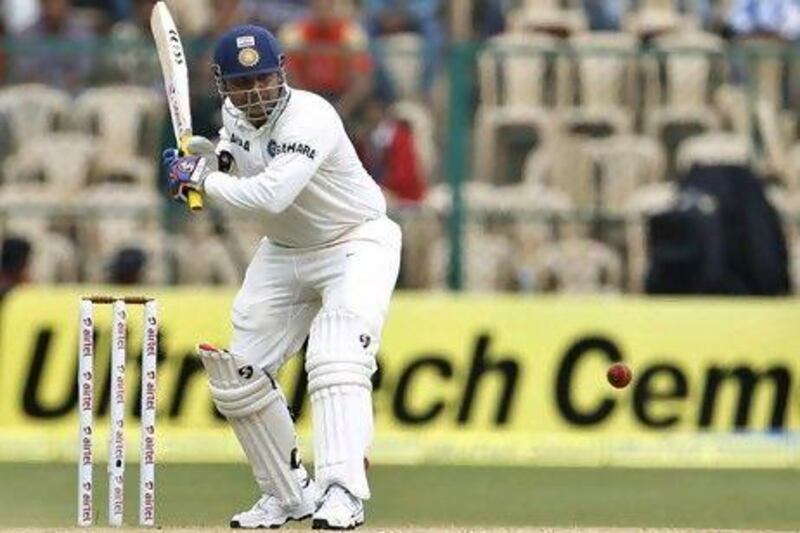I have never managed to create the setting, but have always imagined that the best way to soak in a
[ Virender Sehwag ]
innings would be on a foggy, cold morning in Delhi, so cold your bones hurt, with some sweet chai (tea) and paratha (a sexier cousin of naan bread).
I am not sure why but it could be that the effect of his batting glues together something of these senses; the cold, cruel and biting put-down of bowlers; the warmth and crunch of a paratha in each of his individual boundaries; and how, after a while, his excessive boundary hitting feels like the sick excess of sugary tea.
(His boundary striking is so punishing that it becomes numbing, crossing a line after which it can even be belittled as a mere consequence of the toothlessness of bowling and surfaces; so good, in other words, you have to ask how bad everything else is.)
Sometime this November Sehwag will complete 100 Tests. On two levels that requires a moment's pause for thought.
At one, it says, contrary to popular condemnation, that
[ India ]
do actually play plenty of Tests. Sehwag will have been a Test cricketer for 11 years when he plays his 100th and had he not missed a year because of poor form he would have played nearly 120 Tests by now (a fair haul for an 11-year career).
But at the other, a century of Tests accords Sehwag a deeper status, a seniority he has allowed to pass him by for much of his career. He has been a senior player for a while, of course, but in a batting order of Rahul Dravid, VVS Laxman and
[ Sachin Tendulkar ]
, seniority comes to mean a different thing entirely.
Sehwag's veteran-ism, like his batting, has its own space, under these three but above MS Dhoni, Gautam Gambhir and even Zaheer Khan, whose career has acquired an impermanence because of his injuries. The only other player who might be there is Harbhajan Singh, also on 98 Tests.
But as his landmark approaches, Sehwag finds himself delicately placed. Immediately behind him stretch two underwhelming years, years of an incompleteness. He averages 35, has not hit a Test hundred since November 2010 (but has nine 50s and nine other scores above 20 in 16 Tests) and outside the subcontinent has been dismal for longer.
The game is mocking him back now. You thought you had mastered me? Not so easy now is it?
His in-between status has allowed this to go not unremarked but under-dissected.
The troubles of those more senior and the fortunes of those junior have been handy distractions.
Take last week in Bangalore against New Zealand; the kind of opprobrium directed towards Suresh Raina's panicked dismissal to Jeetan Patel outweighed Sehwag's own ill-thought rush. He is also a formless player, in that he never looks in or out of form.
Long or brief, every innings has polished-clean boundaries and air drives. He has not looked terrible these two years, he has just kept getting out and if that is an obvious thing to say, it makes it more difficult to know what will come now. Because ahead of him awaits, inescapably, true seniority and its exponentially greater scrutiny. Something will give, either his place or his style.
There is a school of thought which worries that Sehwag's peak has passed, that Sehwag, a creature who let his hands react instantly and instinctively to what his eyes processed, is getting older as his eyes and hands get slower and their communication poorer.
They also worry he does not have the technical base to fall back on to reconfigure his game.
But actually, Sehwag has a pretty solid technique, or at least a successful one. How can he not with his record? The bigger concern must be whether he is willing to adapt his game to how his body is changing, to how he is now being bowled to, to eliminate risk like Tendulkar has done. Can he go from being a batsman whose existence brought runs to one who accumulates runs to exist?
He is smart enough and cares enough to do it. And on occasion, he has done it (it is not a prerequisite but great batsmen have invariably been great adapters) but can he do it now and prolong it until he goes? Regenerating at 34 requires an obscene amount of sacrifice.
In the dressing room he has talked of moving to the middle order, though whether that is a serious consideration is not clear.
That way could lie further danger. The mood of a game when the middle order bats inverts Sehwag's natural tendency; that is, these days most bowling sides defend as a form of attack at that stage where Sehwag attacks as his form of defence. He could easily be neutered.
All of which is to come to the conclusion - and it is a dispiriting one - that his best days may really be gone and crucially, at just the time India need most from him.
Sehwag says that he sometimes hums Kishore Kumar tunes while batting. If true (even if it isn't, let's agree that it should be), then he has only been scoring his creations with an appropriate soundtrack, because just as with Kumar's best songs, there also lay in Sehwag's greatest batting the lightest and chirpiest affirmations of life itself.
Follow us
[ @SprtNationalUAE ]





